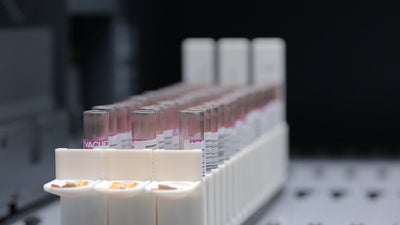Blood cancer: Leukaemia
Overview of leukaemias: types, treatment and outlook.
Understanding leukaemia
Leukaemia is one of the three main types of blood cancers, alongside lymphoma and myeloma.
Leukaemia affects the white blood cells — crucial defenders in our immune system — and is divided into two main categories based on how quickly the disease progresses: acute and chronic.
While chronic leukaemia often progresses slowly, allowing time for more deliberation in treatment options, acute leukaemia require prompt and decisive treatment due to their rapid progression. It is important to find out from your doctor which type of leukaemia you have. Your doctor will choose the best treatment for you depending on the type.
In cancer care, doctors often use the term 'remission' instead of 'cure' because cancer can recur even after treatment. If there are no signs of the disease after treatment, it's called 'remission'. The longer the remission lasts, the lower the chances of cancer returning. The risk of recurrence varies widely depending on the type of cancer or leukaemia you have.
Learn more: Blood cancer
Types of leukaemia
Acute leukaemia
Acute leukaemia is a rapidly progressing cancer where the affected cells are highly immature and abnormal. These cells fail to perform the essential function of white blood cells: fighting infections. Instead, they multiply uncontrollably, leading to an overwhelming number of these defective cells. This overproduction crowds out normal blood cells – both red blood cells and other types of white blood cells – severely impacting the body's ability to function properly.
Acute leukaemia develop swiftly and require immediate medical attention. Without prompt treatment, the condition can deteriorate rapidly, often within weeks, making early intervention crucial.
Types of acute leukaemia
There are two primary types of acute leukaemia:
- Acute lymphoblastic leukaemia (ALL): affects lymphoblasts—these are immature forms of lymphocytes, which are involved in immune responses. When these cells become cancerous, they multiply uncontrollably.
- Acute myeloid leukaemia (AML): involves myeloblasts, which are immature precursors of granulocytes. Granulocytes help fight infections by "engulfing" bacteria and other invaders. In AML, myeloblasts grow abnormally and can't function properly.
Chronic leukaemia
Chronic leukaemia is a type of cancer where white blood cells grow and multiply abnormally. Unlike normal white blood cells, these affected cells can't fight infections as effectively. They do still function to some extent, but not as well as healthy cells. The multiplication rate of these cells is slower than in acute leukaemia but still faster than normal.
Chronic leukaemia develop gradually over months or even years. Without treatment, they do worsen, but at a much slower rate. Initially, you might not experience any symptoms. The approach to treatment varies based on the specific type of chronic leukaemia.
Types of chronic leukaemia
Chronic leukaemia is categorised into three main types, each named after the specific white blood cell affected:
- Chronic lymphoblastic leukaemia (CLL): this starts in lymphocytes, affecting their ability to fight infections.
- Chronic myeloid leukaemia (CML): This impacts myeloid cells, leading to an overproduction of these cells, which don’t work properly to combat infections.
Risk factors & myths about causes
Leukaemia has several known risk factors. While the exact cause remains uncertain, certain genetic and environmental factors can increase the risk. Common risk factors include exposure to high levels of radiation, previous chemotherapy or radiation treatments, and exposure to chemicals like benzene. Genetic disorders such as Down syndrome and certain inherited conditions also elevate the risk. Smoking is strongly linked to acute myelogenous leukaemia (AML), and a family history of leukaemia can slightly increase one's risk.
A popular myth is that leukaemia is caused by an unhealthy lifestyle or poor diet. While maintaining a healthy lifestyle is crucial for overall well-being, there is no direct evidence linking diet to leukaemia development. Similarly, everyday stress and anxiety are not causes of leukaemia, despite common misconceptions.
Recognising leukaemia symptoms
Leukaemia symptoms can vary widely and are often subtle at first. Common signs include persistent fatigue, frequent infections, unexplained weight loss, and easy bruising or bleeding. Other symptoms might include swollen lymph nodes, night sweats, and bone or joint pain. Because these symptoms can be associated with many other conditions, it's important to consult a healthcare provider if you experience any persistent or unusual symptoms.
Treatment options for leukaemia
Treatment for leukaemia depends on the type and stage of the disease, as well as your overall health. Common treatments include:
- Chemotherapy: the most common treatment, which uses powerful drugs to kill leukaemia cells or stop them from growing.
- Radiation therapy: uses high-energy radiation to target and kill cancer cells.
- Targeted therapy: involves drugs that specifically target abnormalities in cancer cells, such as tyrosine kinase inhibitors.
- Immunotherapy: helps boost the body's immune system to fight cancer.
- Stem cell transplant: replaces diseased bone marrow with healthy stem cells from a donor.
Learn more: Treatments for blood cancer and blood disorder
Outlook and living with leukaemia
The prognosis for leukaemia varies widely depending on its type and progression. Advances in treatment have significantly improved survival rates, allowing many patients to lead full lives during and after treatment. Living with leukaemia involves ongoing management and support, benefiting greatly from modern medical advances and supportive care.
A healthy lifestyle, along with emotional support from family, friends, and support groups, is crucial. Each patient's treatment is personalised based on their unique medical history and preferences, aiming to optimise effectiveness and minimise side effects.
Continuous advancements in research and clinical trials are enhancing the understanding and treatment of leukaemia. Staying informed, maintaining open communication with healthcare providers, and proactively managing your health can significantly improve outcomes and quality of life.
Learn more: Blood cancer research at DKMS
A blood cancer or a blood disorder diagnosis can feel overwhelming, but remember, you're not alone. Our team is here, ready to provide support and guidance. Partnering with DKMS can help you share your story and amplify our combined efforts to expand the stem cell registry. This increases the chances of finding a potentially lifesaving match for patients with blood cancers and blood disorders, if a stem cell transplant becomes necessary.
Your wellbeing is our priority, and we're committed to supporting you so do reach out to us. Together, we can create more hope and opportunities for people living with blood cancer.
References
Risk Factors for Leukemia | Memorial Sloan Kettering Cancer Center (mskcc.org) Last reviewed September 2024.
Leukemia: Causes and Risk Factors | Verywellhealth.com. Last reviewed September 2024.
Who Is Most at Risk for Developing Leukemia | Moffitt. Last reviewed September 2024.
Leukemia - Symptoms and causes | Mayo Clinic. Last reviewed September 2024.
Leukemia: Symptoms, Signs, Causes, Types & Treatment | Clevelandclinic.org. Last reviewed September 2024.


